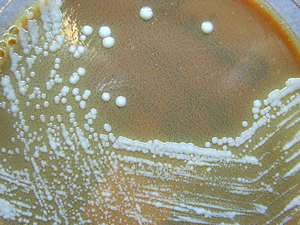About the Project
 Francisella tularensis colonization on Cysteine Heart Agar after 72 hours. Obtained from the CDC Public Health Image Library. Image credit: CDC/Larry Stauffer, Oregon State |
||||||||||||||||||||||||||
Current Status of the Project
Search the Sequence You can download the data from our FTP site. Related Links |
F. tularensis, a small, nonmotile, nonsporulating, gram-negative, coccobacillus is currently one of the most infectious bacteria known and is the causative agent of the systemic disease tularemia, a potentially severe and fatal disease in humans. F. tularensis is also characterized by its resilience to environmental conditions and its ease of dissemination. For these reasons, F. tularensis poses a serious threat to laboratory workers who handle the organism and is a bioterrorism concern.
The gamma-protobacterial family Francisellaceae consists of two genera: Francisella tularensis and Francisella philomiragia. F. tularensis has four subspecies: tularensis (Type A), holarctica (Type B), mediaasiatica (geographically restricted to the central Asia) and novicida (a rare isolate initially isolated from a water source in Utah in 1951). F. tularensis subsp. tularensis, is the most virulent subspecies and is geographically restricted to the North American continent, with only one report of isolation of Type A in Europe. Subspecies holarctica is moderately virulent and is found throughout the Northern hemisphere including the Scandinavian countries, Russia, Spain, Japan and the U. S. Because the subspecies are very similar, diagnostic microbiological identification has relied on differences in virulence and in a small number of non-routine biochemical/DNA assays (e.g. PCR-based DNA fingerprinting analyses).
The subsp. holarctica live attenuated vaccine strain (LVS) is currently the only effective vaccine against tularemia. The vaccine is approved in the U.S. only for use in clinical trials, and its future availability is undetermined because the protective response offered by the vaccine has not been well characterized, the basis of its attenuation is unknown, and the LVS strain is fully virulent when delivered intraperitoneally in mice. The fact that the LVS provides protective immunity suggests that efforts to create a defined attenuated mutant may be fruitful, however such strains may not be available for some time.
We are sequencing the genome of a virulent subsp. holarctica strain, OSU18, which was isolated from a dead beaver in Oklahoma in 1978. This sequence will serve as a comparative genome for other sequenced Francisella strains to identify genetic markers responsible for the differences in virulence and lifestyle among the various Francisella subspecies.
Christopher, G.W., Cieslak, T.J., Pavlin, J.A., and E.M. Eitzen. 1997. Biological warfare: a historical perspective. JAMA 278:412-417
Tarnvik, A. 1989. Nature of protective immunity to Francisella tularensis. Rev. Infect. Dis. 11:440-451.
Gurycova, D. 1998. First isolation of Francisella tularensis subsp. tularensis in Europe. Eur. J. Epidemiol. 14:797-802.